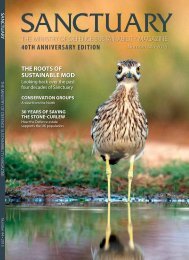SUSTAINABILITY
UBUt5
UBUt5
Create successful ePaper yourself
Turn your PDF publications into a flip-book with our unique Google optimized e-Paper software.
FEATURES<br />
Demolitions + Amphibians = Population<br />
Explosion! At DM Kineton<br />
As the demolition ground cannot be<br />
relocated due to the required safety<br />
buffer zone, the amphibians needed to<br />
be translocated to allow a safe<br />
demolition area to be restored.<br />
Middlemarch Environmental Ltd, the<br />
consultancy arm of our local<br />
conservation charity Warwickshire<br />
Wildlife Trust was called in to survey<br />
the ponds and to determine how the<br />
amphibians could be relocated.<br />
Great crested newt © Crown<br />
Defence Munitions Kineton is located<br />
in Warwickshire. The MOD estate is<br />
2,500 acres in area with 13 miles of<br />
arterial road, 19 miles of railway and<br />
with a 24/7 service if necessary. The<br />
Head of Establishment has a<br />
responsibilit y for approximately 900<br />
people on site or within the<br />
immediate area and it is also home to<br />
a large population of great crested<br />
newt (GCN).<br />
nature of these ponds restricted fish<br />
from colonising, which reduced the<br />
level of predation upon the amphibian<br />
larvae. How could any self-respecting<br />
amphibian resist? The ideal habitat<br />
created by the demolitions literally<br />
resulted in a population explosion.<br />
In recent years GCN have significantly<br />
declined across Europe, and now<br />
Britain suppor ts a large population<br />
which are protected under European<br />
law. Like many other amphibian<br />
species worldwide, smooth newt,<br />
common frog and common toad<br />
have also suffered declines in recent<br />
years either due to habitat loss and<br />
fragmentation or through disease.<br />
They are legally protec ted against the<br />
After decades of use, the demolition<br />
ground, run by Defence EOD<br />
Munitions School (DEMS), an area used<br />
for controlled explosions (referred to as<br />
demolitions) and training, was covered<br />
with craters. Access was becoming<br />
constrained by the water filled craters,<br />
which had become colonised by<br />
aquatic vegetation and surrounded by<br />
tussocky unmanaged grassland. With<br />
no space remaining to undertake the<br />
demolitions without encroaching on<br />
the safety buffer zone, it was time to fill<br />
in the craters and restore the nice flat<br />
demolition area.<br />
However, over decades of use, the<br />
demolition training had inadvertently<br />
created an ideal habitat for amphibians<br />
as the 70 plus craters had become<br />
small vegetation filled ponds suitable<br />
for amphibians to lay their eggs. The<br />
small and sometimes ephemeral<br />
New habitat creation by the Royal Engineers © Steve Edwards<br />
32<br />
Sanctuary 44 • 2015



